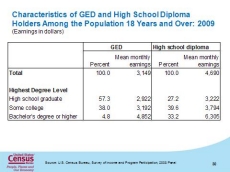GED Recipients Have Lower Earnings, are Less Likely to Enter College
GED Recipients Have Lower Earnings, are Less Likely to Enter College
Although most people complete high school by earning a traditional high school diploma, some complete a high school equivalency by passing the GED test. Most states and many federal programs consider the GED certificate to be formally the same as a high school diploma, yet GED recipients and high school graduates differ in levels of educational attainment and earnings.
In 2009, 16.9 million adults earned a GED certificate to satisfy their high school requirements. While 73 percent of those who received a high school diploma went on to complete at least some postsecondary education, less than half (43 percent) of GED certificate recipients did so. Furthermore, only 5 percent earned a bachelor’s degree or higher. In contrast, of high school diploma holders, 33 percent earned this level of education.
GED certificate holders had lower earnings than those who earned a regular high school diploma regardless of sex, race and ethnicity or age. Overall, high school diploma holders earned approximately $4,700 in mean monthly earnings compared with GED certificate holders, who earned $3,100.
That said, having a GED certificate is much better than having no high school diploma at all. Those with some high school had mean earnings of about $2,400 a month, and those with only an elementary school education earned an average of about $2,100.
In addition to being less likely to pursue a college education, GED certificate holders earned less than high school diploma recipients even when they did achieve higher education. Among adults who attained a bachelor’s degree or higher, the mean earnings of those who earned a high school diploma were approximately $6,300, while the earnings of those who earned a GED certificate were approximately $4,900.
For more details, see our report:




